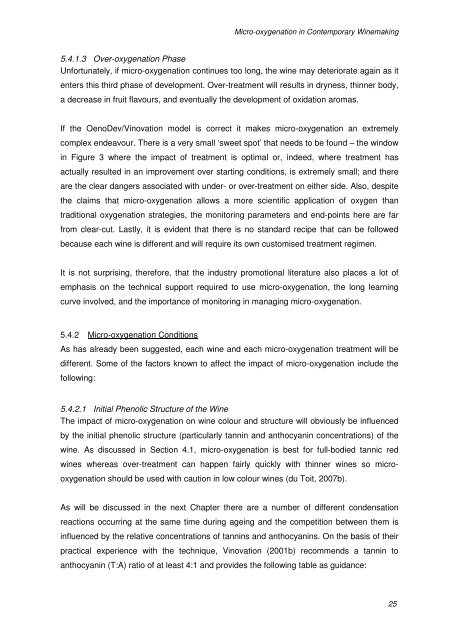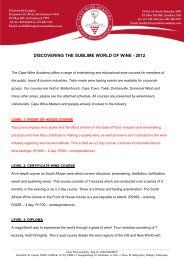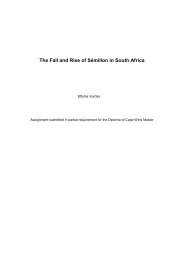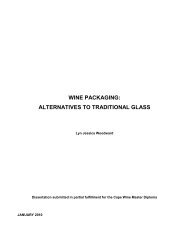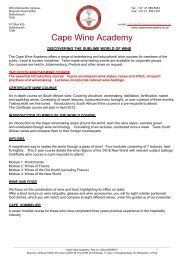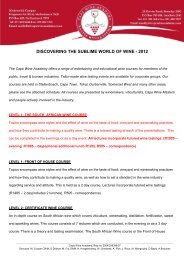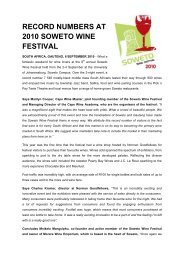micro-oxygenation in contemporary winemaking - Cape Wine ...
micro-oxygenation in contemporary winemaking - Cape Wine ...
micro-oxygenation in contemporary winemaking - Cape Wine ...
Create successful ePaper yourself
Turn your PDF publications into a flip-book with our unique Google optimized e-Paper software.
Micro-<strong>oxygenation</strong> <strong>in</strong> Contemporary W<strong>in</strong>emak<strong>in</strong>g5.4.1.3 Over-<strong>oxygenation</strong> PhaseUnfortunately, if <strong>micro</strong>-<strong>oxygenation</strong> cont<strong>in</strong>ues too long, the w<strong>in</strong>e may deteriorate aga<strong>in</strong> as itenters this third phase of development. Over-treatment will results <strong>in</strong> dryness, th<strong>in</strong>ner body,a decrease <strong>in</strong> fruit flavours, and eventually the development of oxidation aromas.If the OenoDev/V<strong>in</strong>ovation model is correct it makes <strong>micro</strong>-<strong>oxygenation</strong> an extremelycomplex endeavour. There is a very small ‘sweet spot’ that needs to be found – the w<strong>in</strong>dow<strong>in</strong> Figure 3 where the impact of treatment is optimal or, <strong>in</strong>deed, where treatment hasactually resulted <strong>in</strong> an improvement over start<strong>in</strong>g conditions, is extremely small; and thereare the clear dangers associated with under- or over-treatment on either side. Also, despitethe claims that <strong>micro</strong>-<strong>oxygenation</strong> allows a more scientific application of oxygen thantraditional <strong>oxygenation</strong> strategies, the monitor<strong>in</strong>g parameters and end-po<strong>in</strong>ts here are farfrom clear-cut. Lastly, it is evident that there is no standard recipe that can be followedbecause each w<strong>in</strong>e is different and will require its own customised treatment regimen.It is not surpris<strong>in</strong>g, therefore, that the <strong>in</strong>dustry promotional literature also places a lot ofemphasis on the technical support required to use <strong>micro</strong>-<strong>oxygenation</strong>, the long learn<strong>in</strong>gcurve <strong>in</strong>volved, and the importance of monitor<strong>in</strong>g <strong>in</strong> manag<strong>in</strong>g <strong>micro</strong>-<strong>oxygenation</strong>.5.4.2 Micro-<strong>oxygenation</strong> ConditionsAs has already been suggested, each w<strong>in</strong>e and each <strong>micro</strong>-<strong>oxygenation</strong> treatment will bedifferent. Some of the factors known to affect the impact of <strong>micro</strong>-<strong>oxygenation</strong> <strong>in</strong>clude thefollow<strong>in</strong>g:5.4.2.1 Initial Phenolic Structure of the W<strong>in</strong>eThe impact of <strong>micro</strong>-<strong>oxygenation</strong> on w<strong>in</strong>e colour and structure will obviously be <strong>in</strong>fluencedby the <strong>in</strong>itial phenolic structure (particularly tann<strong>in</strong> and anthocyan<strong>in</strong> concentrations) of thew<strong>in</strong>e. As discussed <strong>in</strong> Section 4.1, <strong>micro</strong>-<strong>oxygenation</strong> is best for full-bodied tannic redw<strong>in</strong>es whereas over-treatment can happen fairly quickly with th<strong>in</strong>ner w<strong>in</strong>es so <strong>micro</strong><strong>oxygenation</strong>should be used with caution <strong>in</strong> low colour w<strong>in</strong>es (du Toit, 2007b).As will be discussed <strong>in</strong> the next Chapter there are a number of different condensationreactions occurr<strong>in</strong>g at the same time dur<strong>in</strong>g age<strong>in</strong>g and the competition between them is<strong>in</strong>fluenced by the relative concentrations of tann<strong>in</strong>s and anthocyan<strong>in</strong>s. On the basis of theirpractical experience with the technique, V<strong>in</strong>ovation (2001b) recommends a tann<strong>in</strong> toanthocyan<strong>in</strong> (T:A) ratio of at least 4:1 and provides the follow<strong>in</strong>g table as guidance:25


